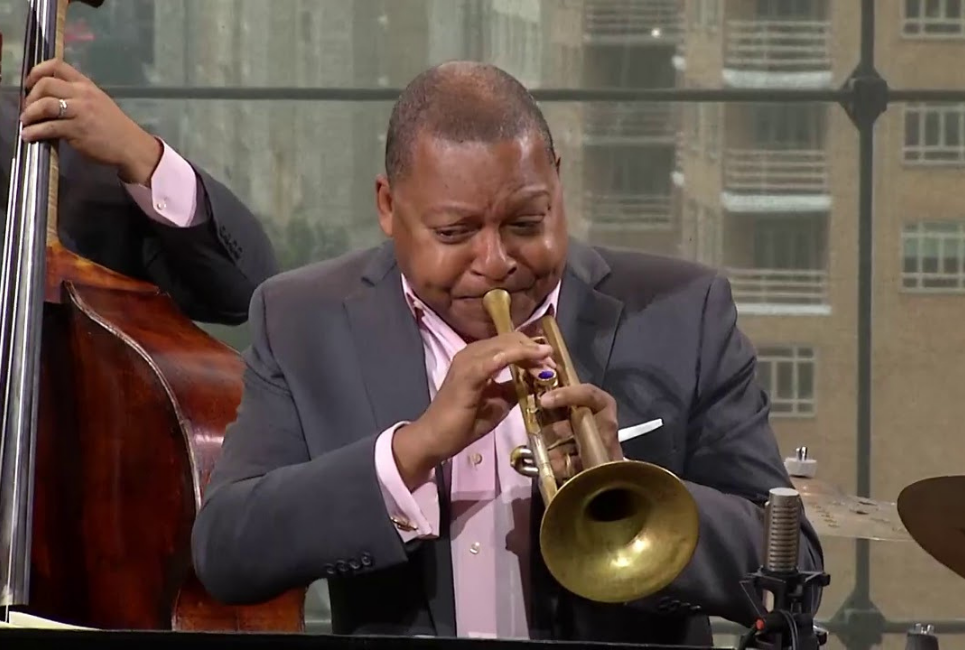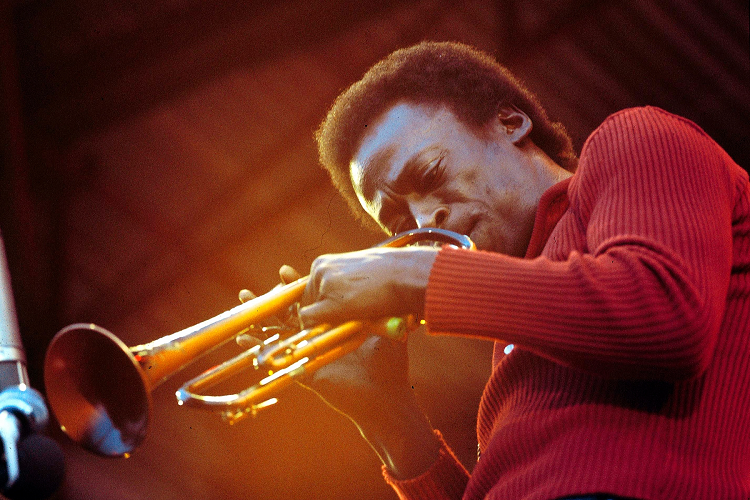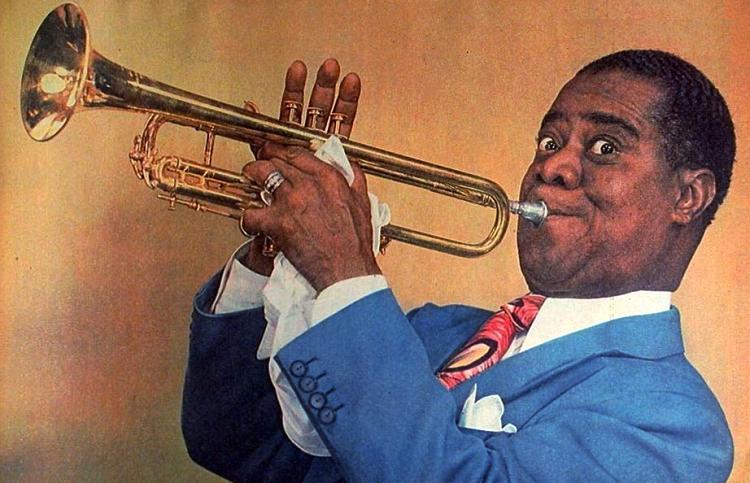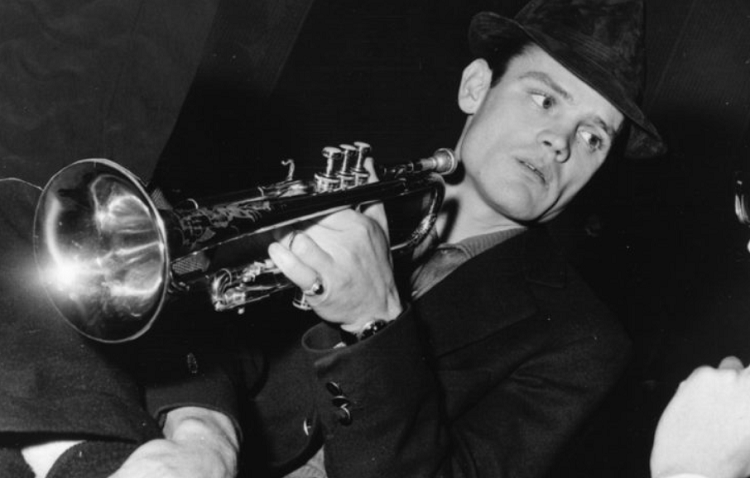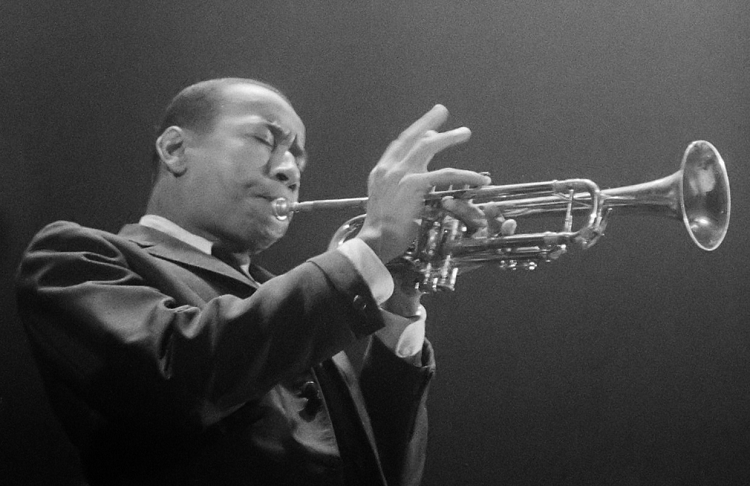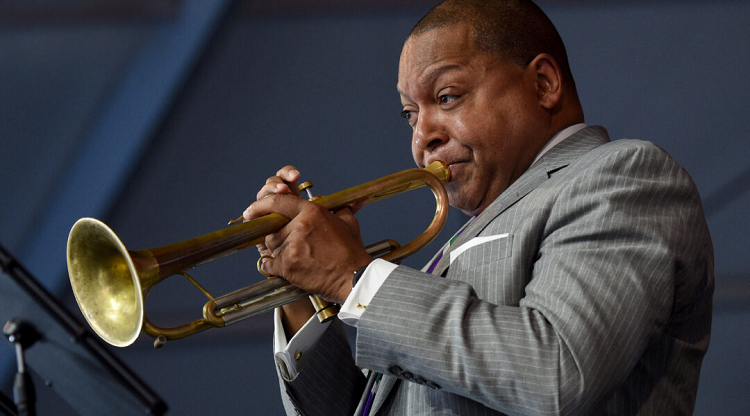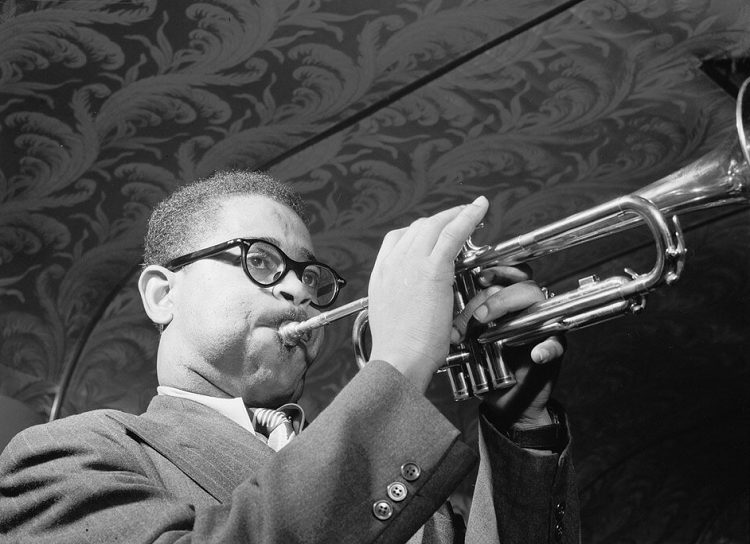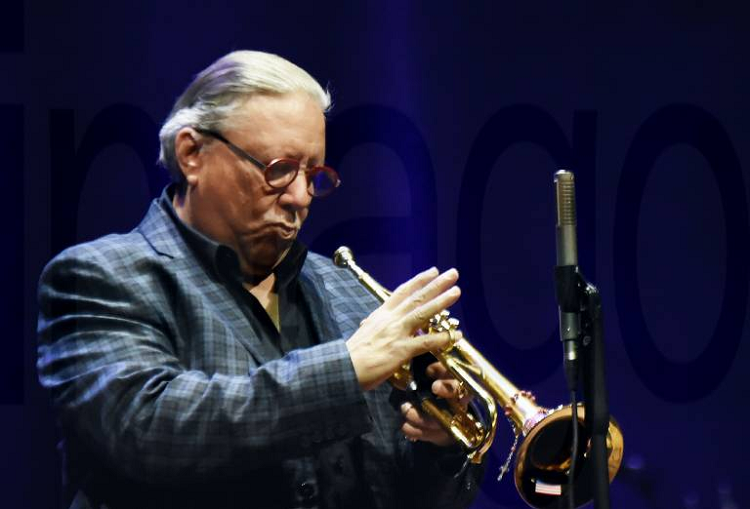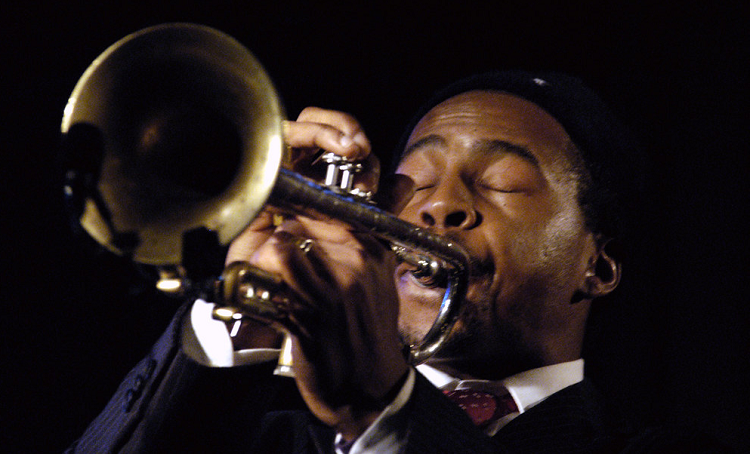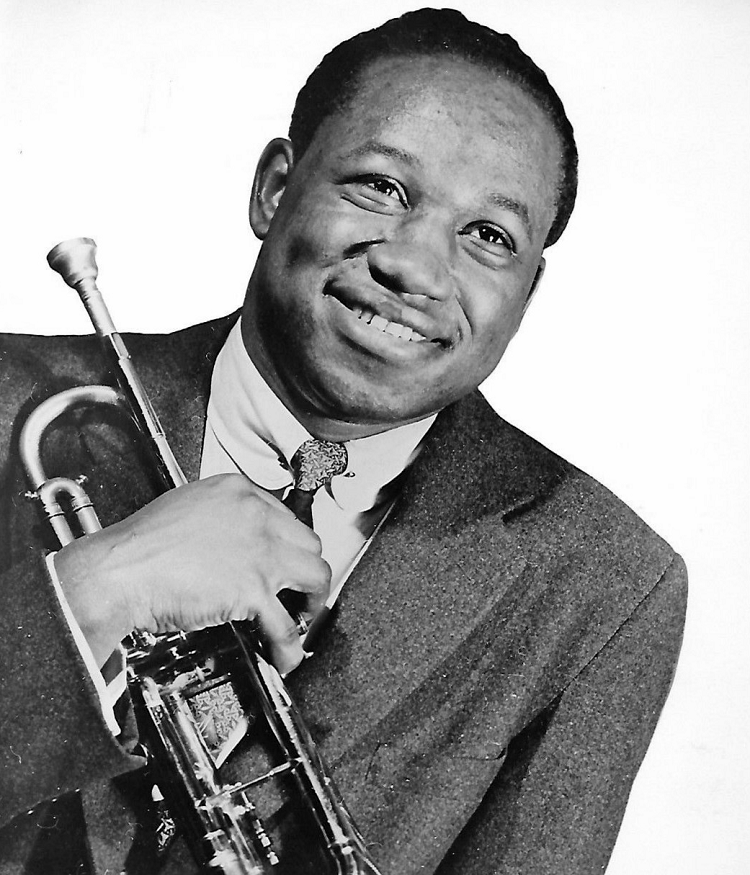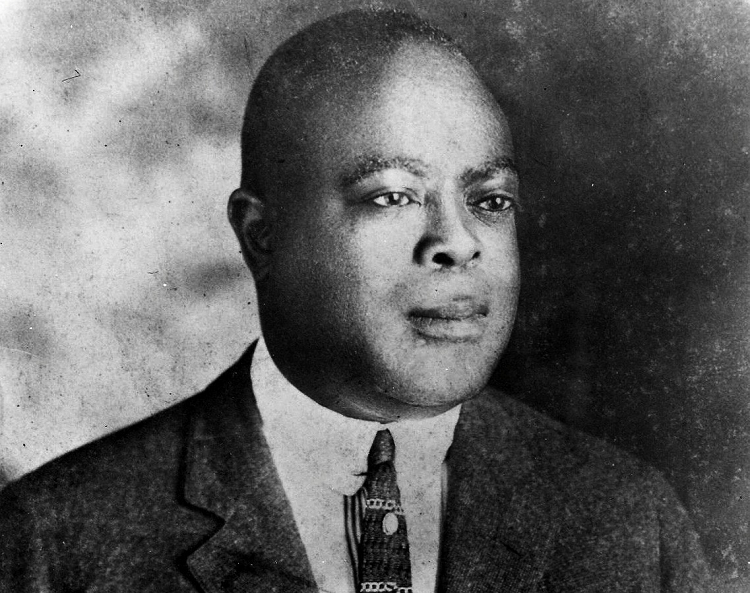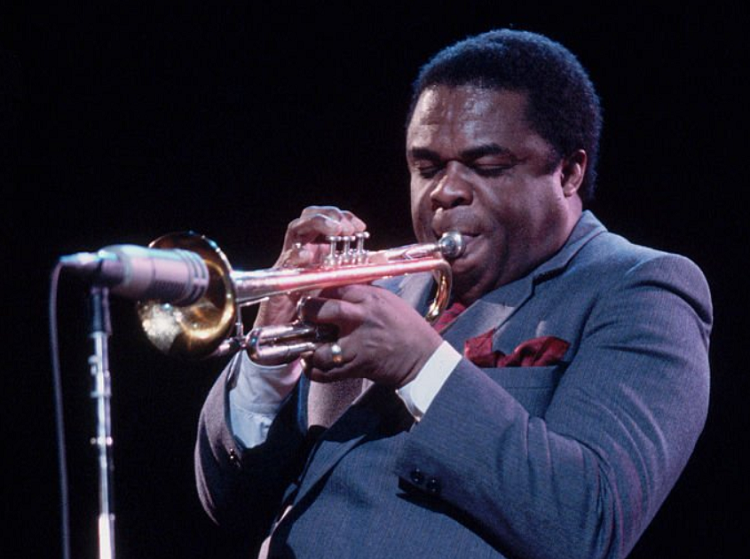- Jazz Trumpet Players - April 3, 2022
The trumpet is an instrument that has been heard in jazz recordings for decades. Since it is one of the loudest instruments from those that typically belong in a jazz formation, it is generally the “leader” or the instrument that plays the melody and solos.
Since the early days, many musicians responsible for big changes in jazz music were trumpet players, such as Louis Armstrong and Miles Davis, two legends who have changed the course of jazz more than once.
In this article, we will take a closer look at some of the most influential trumpet players in jazz. They have recorded some of the most important and influential records in music history and played some of the most amazing live performances throughout their careers.
Miles Davis (1926-1991)
Miles Davis is without a doubt one of the most important musical and cultural icons of the twentieth century, and simply can’t be left out from a list of the best jazz trumpet players for so many reasons.
His career lasted over four decades, from the early ’40s to the early ’90s. During this time, he managed to change music forever, and achieve incredible feats like recording the world’s best-selling jazz record, Kind of Blue, which came out on August 17, 1959.
Miles was not only responsible for reinventing jazz several times on his own, but also for bringing many unknown musicians into fame.
Many players who were a part of his band went on to have amazing solo careers, such as John Coltrane, Herbie Hancock, Tony Williams, Chick Corea, John McLaughlin, Billy Cobham, Marcus Miller, John Scofield, and many more.
Miles Davis was at the forefront of many musical revolutions. His unique approach to the trumpet allowed him to create something entirely different from what people expected from his instrument at the time.
While he was coming up, other trumpet icons such as Dizzy Gillespie and Henry James were known for full, intense and loud tones. Miles went the other way and decided to explore other colors and textures that the trumpet could provide.
He used the Harmon mute to obtain legendary tones that can be heard on records such as the iconic Kind of Blue. By using this accessory, he tamed the sound of the trumpet to make it smoother.
He used space, slight bends, dynamics, and an amazing swing to create some of the world’s most treasured jazz records. His extensive discography covers a very wide range of styles.
For instance, the records In a Silent Way (1969) Bitches Brew (1970) dip heavily into the jazz fusion genre. It sounds radically different from other albums of his such as Birt of the Cool (1957).
With Miles, you really should take the time to sit down and go through his discography little by little, appreciating the differences and evolution from one album to the other, appreciating how jazz music was transformed over the years.
Records You Should Check Out by Miles Davis
Kind of Blue (1959)
Kind of Blue is one of those albums that is always mentioned when discussing influential records in jazz. This one was recorded in 1959 with minimal preparations, in a short time, and went on to become the world’s best-selling jazz record.
An all-star formation including John Coltrane, Cannonball Adderley, Bill Evans, and Wynton Kelly complemented Miles’ playing beautifully.
If you consider yourself a jazz fan, this record has to be on your shelf, mandatorily!
In a Silent Way (1969)
In a Silent Way was released in 1969, and contained many textures that were not typical of Miles Davis’ records until that point. This can be credited to the band’s members, who bring different influences and colors to the table.
For instance, guitarist John McLaughlin and Chick Corea make their appearances playing the electric guitar and electric piano, steering away from the more traditional formation that you can hear on older records.
This record is an excellent way to understand how music transitioned from a more pure form of jazz to a fusion of different genres including rock, funk, pop and jazz, since several of the band’s members went on to become some of the most important musicians in the jazz-fusion scene.
Birth of the Cool (1957)
You can say that Miles changed music several times throughout his career. One of those times was when Birth of the Cool was released in 1957.
Miles started the cool jazz movement by introducing his laid-back, unique style of playing that ended up being his signature style.
It was recorded in three sessions, arranged by Gil Evans, and included jazz legends such as Gerry Mulligan, Lee Konitz and Max Roach in its formation.
Louis Armstrong (1901- 1971)
It is fair to say that Louis Armstrong was the most influential and popular jazz musician in history. There are countless important musicians that deserve credit for their contributions to jazz, but Louis was the first real jazz superstar and influenced pretty much everyone who came after him.
Armstrong was born in New Orleans in 1901, growing up in a poor neighborhood. He had a rough childhood and ended up in a juvenile detention center. This was where he picked up the cornet, a wind instrument similar to the trumpet.
When he was 18, he managed to get a job playing the trumpet in Kid Ory’s Original Creole Jazz Band, one of the most important groups of the time.
It was at this point that Louis started gaining recognition for his improvisation chops. Armstrong went on to make jazz soloing popular, and was one of the main responsible for introducing jazz to the rest of the world.
Apart from his contributions with his trumpet playing, Armstrong was also one of the most influential jazz singers ever, and he made scat singing popular too. Some of his most recognizable recordings include “What a Wonderful World” and “West End Blues”.
Records You Should Check Out by Louis Armstrong
What a Wonderful World (1967)
The album What a Wonderful World was released in 1967, and it is also the title of the song that people generally associate Armstrong to the most.
It was a smashing hit, and it consolidated Louis as a pop singer, not just a jazz trumpeteer, although he had been singing a lot prior to this release as well.
Other notable tracks from this album include “Dream A Little Dream Of Me” and “Cabaret”.
Ella and Louis (1965)
Louis Armstrong collaborated with Ella Fitzgerald, one the most amazing voices of all time in the record Ella and Louis, that came out in 1965.
This record was also the first time that Armstrong worked with the label Verve Records, and it eventually led to another recording featuring this duo.
This album features a variety of amazing duets in which both voices complement each other perfectly, despite being so different. Some of the most interesting tracks include “Cheek to Cheek”, “Can’t We Be Friends” and “They Can’t Take That Away From Me”.
Louis Armstrong and his Hot Five and Hot Seven Recordings (1925-1928)
Louis Armstrong recorded several sessions with a band that he formed after playing with King Oliver and Fletcher Henderson in his earlier days.
This band was called the Hot Five, which later became the Hot Seven. The band members were Lil Harding (piano), Kid Ory (trombone), Johhny Dodds (clarinet), Johnny St. Cyr (banjo/guitar), Baby Dodds (drums), and Pete Briggs (tuba). Kid Oris was also replaced by John Thomas during some time.
In these recordings, you can hear some of the finest solos that Louis Armstrong ever played, demonstrating an impressive mastery of the instrument, swing, harmonic concepts, rhythmic play, and a sense of musicality that few musicians can get close to.
It was during these recordings that something extraordinary happened by accident – Louis dropped the sheet of paper that contained his lyrics while recording the song “Heebie Jeebies”.
Since recording in a studio was expensive and they did not want to compromise that take, Louis started to improvise a small solo with random sounds. This became the technique that we now know as “scat singing”.
Chet Baker (1929-1988)
Chet Baker was born in 1929 in Yale, Oklahoma. He became one of the leading figures in the cool jazz genre. He was also an accomplished singer, and many of his records feature him on vocals and trumpet.
Unfortunately, Baker’s life was not uneventful, as he struggled with a drug addiction for a large part of his career, and suffered a tragic death in Amsterdam, where he fell from a hotel’s balcony.
Chet’s playing style was more unique. He had a natural aptitude for melody, his phrases were sweet, smooth, and came out effortlessly, complementing each song beautifully.
Some of his most famous associated acts include Charlie Parker, Paul Desmond, Gerry Mulligan, and Stan Getz. Two of his most successful records are Chet Baker Sings (1954) and It Could Happen to You (1958).
Records You Should Check Out by Chet Baker
Chet Baker Sings (1954)
The world got to know Chet Baker when he released his debut album, Chet Baker Sings, in 1954. This record includes some of his best-known classics such as “My Funny Valentine”, “There Will Never Be Another You” and “But Not For Me”, the opening track.
This album received the Grammy Hall of Fame award in 2001 and is widely regarded as one of Chet’s finest works. This record features several renowned jazz musicians such as Russ Freeman (piano), Jimmy Bond (double bass), and Larance Marable (drums).
It Could Happen to You (1958)
Recorded in 1958 for the Riverside label, It Could Happen to You is another classic Chet Baker record in which he interprets popular songs with a jazz feel. Like in Chet Baker Sings, every track is written by other authors, but this does not get in the way. His shining performances almost make the songs his.
Some of the most popular tracks are “It Could Happen to You”, which features a scat solo, “Everything Happens to Me” and “I’m Old Fashioned”.
Chet is Back! (1962)
Throughout his life, Chet Baker got in trouble several times on account of his drug addiction. He was arrested for 18 months in Italy in the 60s, and when he got out, he was invited by the RCA Studios in Rome to record this album.
The band featured in this record was composed of European musicians that were not as famous as other bandmates in earlier Chet Baker records, but they sound great regardless.
It includes songs from other known jazz artists such as “Well, You Needn’t” by Thelonious Monk, “Barbados” by Charlie Parker, and “Pent-Up House” by Sonny Rollins.
Lee Morgan (1938-1972)
Edward Lee Morgan was one of the leading musicians in the hard bop era that came about in the 1960s. He was one of the most recognized musicians associated with the label Blue Note, with 25 albums recorded as a leader for them.
He played with many jazz icons such as Dizzy Gillespie, John Coltrane, Hank Mobley, and Art Blakey. He was one of the cornerstones of the accomplished group Art Blakey’s Jazz Messengers, with whom he recorded “Moanin'”, a well-known jazz standard that is frequently played by ensembles worldwide.
Morgan suffered a tragic death at age 33 when he was shot by his wife at the club where he was performing with his band.
Records You Should Check Out by Lee Morgan
The Sidewinder (1964)
The Sidewinder is arguably Lee Morgan’s best album, released by Blue Note in 1964. It reached 25th place on the Billboard charts, and features excellent tunes apart from the one that named the album, “The Sidewinder”.
You can hear Morgan backed up by Joe Henderson on the tenor sax, Barry Harris on the piano, Bob Cranshaw on the double bass and Billy Higgins on the drums.
The Cooker (1958)
The Cooker is an album that you can’t skip when exploring Lee Morgan. It features him alongside Pepper Adams (baritone sax), Bobby Timmons (piano), Paul Chambers (bass), and Philly Joe Jones (drums).
The most famous track of this record is without a doubt “A Night in Tunisia”.
Wynton Marsalis (1961-Present)
Wynton Marsalis is a trumpeter from New Orleans who was born in 1961. Apart from being a performer, he is also a composer, teacher and director of Jazz at Lincoln Center, in New York City.
He has had a very successful career, with a total of 9 Grammy Awards, having won a jazz and a classical award in the same year, a feat that no other musician has accomplished.
Marsalis is a huge advocate of the American culture and likes to emphasize the importance of tradition and studying from the original masters. Despite having this approach, he has composed music of many kinds, from traditional to modern jazz.
Apart from his glowing solo career, he has also played with countless jazz legends such as Art Blakey, Sonny Rollins, Dizzy Gillespie, Herbie Hancock, Ron Carter, and many more.
His love for classical music also gave him the chance to perform with some of the world’s most famous orchestras such as the Los Angeles Philarmonic, New York Philarmonic, and London’s Royal Philarmonic.
As a producer, Marsalis has left his mark on over 100 records which have sold over seven million copies worldwide, not to mention the countless musicians that he has influenced through his own records and masterclasses in various countries.
Records You Should Check Out by Wynton Marsalis
Wynton Marsalis (1982)
The album Wynton Marsalis starts Wynton’s career as a jazz trumpeter. This record was produced for Columbia, and it was recorded at the CBS Studios in New York City.
It contains seven tracks, most of them written by some of the band’s members such as Wynton himself, Herbie Hancock, Ron Carter, and Tony Williams.
This record was a success for Wynton Marsalis, reaching number 9 on the Billboard Jazz Albums chart, which is great for a debut album.
Black Codes (From the Underground) (1985)
Black Codes (From the Underground) is one of Wynton’s most appreciated albums. It received two Grammy Awards in 1985.
Marsalis is accompanied by his brother, Branford Marsalis on the tenor and soprano saxophone, Kenny Kirkland (piano), Charnett Moffett (double bass), Jeff “Tain” Watts on the drums, and Ron Carter on the bass for just one song.
Dizzy Gillespie (1917-1993)
John Birks Gillespie, more commonly known as Dizzy Gillespie, was one of the most important trumpeters in the history of jazz, with a characteristic style of playing and unique ability to improvise.
Dizzy was responsible for mixing the bebop language with Afro-Cuban rhythms, opening up a whole new world for jazz. His signature tune “Nights in Tunisia” combines several different sounds and rhythms that make it one of the most unique jazz standards in history. Other famous compositions of his include “Groovin’ High” and “Salt Peanuts”.
Dizzy Gillespie worked with many jazz legends such as Charlie Parker, John Coltrane, Ray Brown, Kenny Clarke, and many others. During his career, he was given important awards such as the Grammy Lifetime Achievement Award and a Polar Music Prize.
Records You Should Check Out by Dizzy Gillespie
Have Trumpet, Will Excite! (1959)
Dizzy Gillespie released the album Have Trumpet, Will Excite! in 1959. His bandmates for the sessions were Junior Mance (piano), Lex Humphries (drums), Sam Jones (double bass), Les Spann (guitar and flute), and Carlos “Patato” Valdes (conga).
This record features the group’s interpretations of old swing songs with their personal twist, which gives the repertoire a completely new sound. Watch out for amazing solos from every band member!
Afro (1954)
Afro, Dizzy’s 1954 release, shows you the result of pairing this trumpet virtuoso with Latin jazz musicians from Cuba, among other stars.
The album was recorded in two separate sessions. One of them features Dizzy with Chico O’Farrill, a Cuban arranger and composer, and the other session includes him with a Latin rhythm section and Gilberto Valdés on the flute.
Other famous participants include Quincy Jones on the trumpet and Hank Mobley on the tenor saxophone.
Arturo Sandoval (1949-Present)
Arturo Sandoval is one of the leading trumpeters of today, with lots of achievements both in jazz and Latin music. Sandoval was born in Cuba and obtained his American citizenship in 1998.
Arturo has been awarded a total of 10 Grammy Awards, as well as 19 nominations. He has been awarded an Emmy Award for the music in a movie about his life. He has received Grammy Award nominations for his song “A Mis Abuelos”, in the categories of Best Instrumental Composition and Best Arrangement.
Other important prizes and achievements of his include the Presidential Medal of Freedom, awarded by Barack Obama in 2013, and 6 Billboard Awards.
Arturo met Dizzy Gillespie in 1977, one of his idols. A few years later, they went on tour, and Dizzy eventually asked him to come play in the United Nations Orchestra. This involvement would be the beginning of Sandoval’s plan to defect from Cuba, which he managed to do successfully.
He has had a much accomplished career, playing with world-class artists of various styles including jazz, Latin and classical music.
Some of his most famous associated acts include Tito Puente, Paquito D’Rivera, Irakere, Frank Sinatra, Alejandro Sanz, the Los Angeles Philharmonic and the National Symphony Orchestra.
As an educator, he has given master classes around the world, has taught at the Florida International University and at the Whitworth University.
Records You Should Check Out by Arturo Sandoval
Turi (1981)
Turi by Arturo Sandoval came out on March 10, 1981. Most of the songs were composed by Arturo himself, including the title track “Turi”.
This record involved a large team. Some of the highlights of the band are Carlos Del Puerto on the bass, Carlos Emilio Morales on the guitar, Chucho Valdés on the piano, and Enrique Plá on the drums.
Arturo Sandoval (1982)
Arturo’s self-titled album came out in 1982, one year after Turi. This time, all of the songs are other authors’ compositions, such as Rubén Fuentes and António C. Jobim.
It features the Egrem Orchestra, comprised of skilled musicians that deliver flawless interpretations of every song on the album.
Roy Hargrove (1969-2018)
Roy Hargrove was an American trumpeter who is referenced all the time when discussing influential jazz musicians. He also played the flugelhorn, but his main instrument was the trumpet.
Roy Hargrove was first discovered by Wynton Marsalis when he was still young. He said that some of his most important influences were Freddie Hubbard, David “Fathead” Newman, and one of his music teachers, Dean Hill, for teaching him the basics of how to improvise.
Roy won a Grammy Award for Best Latin Jazz Album in 1998, and his second one in 2002 for Best Jazz Instrumental Album. Apart from these two, he has also been nominated for 4 other Grammy Awards.
During his career, he played with jazz giants such as Herbie Hancock, Michael Brecker, Jimmy Cobb, and many other artists of different genres such as D’Angelo, Questlove, Nile Rodgers, and many more.
He recorded over 20 albums as a leader and appeared as a sideman on dozens of records during his career. The band “The RH Factor” was one of his most successful projects. His song “Strasbourg-St. Denis” is arguably his most famous composition. It is frequently called out at jam sessions.
He left us in November 2018, due to cardiac arrest, brought on kidney failure, at a hospital in New Jersey.
Records You Should Check Out by Roy Hargrove
Diamond In The Rough (1990)
Roy Hargrove released Diamond In The Rough in 1990. This was his debut album, containing some of his own tunes such as “A New Joy”, “Confidentiality” and “All Over Again”, as well as known songs by other composers such as “Whisper Not” by Benny Golson.
It was recorded at the BMG Recording Studios in New York City.
Habana (1997)
Habana came out in 1997, and in the following year, it received a Grammy Award for Best Latin Jazz Performance. It features some of the world’s best musicians of this genre, such as Chucho Valdés on piano and Horacio “El Negro” Hernandez on drums. Idris Muhammad also played drums on one of the tracks, titled “Nusia’s Poem”.
Other albums worth checking out by Roy Hargrove include his work with The RH Factor. I would personally start with Hard Groove, released in 2003.
Clifford Brown (1930-1956)
Despite his short life, taken away tragically in a car accident at the age of 25, Clifford Brown remains one of the most influential trumpet players in jazz history.
Even though he was only in activity between 1949 and 1956, he left a legacy containing several tunes that became jazz standards, such as “Joy Spring”, “Sandu” and “Daahoud”.
Quincy Jones considers him to be one of the most important musicians of all time, placing him at the same level as other giants such as Charlie Parker and Ella Fitzgerald.
Like most jazz musicians and especially trumpeters, Brown said he was influenced by Louis Armstrong, but also Fats Navarro and Roy Elridge. Some of his most famous associated acts include Art Blakey, Lionel Hampton, Max Roach, Horace Silver and Dizzy Gillespie.
Clifford always steered clear of any drugs and alcohol, and this made other musicians such as Sonny Rollins look up to him, drawing inspiration from the fact that he was able to be clean and still perform wonderfully.
Records You Should Check Out by Clifford Brown
Clifford Brown with Strings (1955)
Clifford Brown with Strings is a mandatory album for fans of this amazing trumpeter who left us too soon. Released in 1955, this album contains several known standards such as “Embraceable You” and “Blue Moon”.
Brown was accompanied by Richie Powell (piano), Max Roach (drums), George Morrow (double bass), and Barry Galbraith (guitar). Neal Hefti was the arranger and conductor of the strings sections.
This record displays Brown’s ability to shine in ballads, and not just in up-tempo bebop tunes.
Clifford Brown & Max Roach (1954)
This album belongs to Clifford Brown and Max Roach, who had worked together previously before recording it. The rest of the band were Harold Land (tenor saxophone), Richie Powell (piano), and George Morrow (bass).
It is regarded as one of the most important and influential jazz records up to this point in time, and features two of Clifford’s songs that later became jazz standards, “Joy Spring” and “Daahoud”.
You can clearly hear that Clifford Brown and Max Roach had impeccable chemistry when playing together, especially when you pay attention to Roach’s comping while Brown is soloing.
King Oliver (1881-1938)
You can’t leave out King Oliver from a list of great jazz trumpeters. While many people consider Louis Armstrong to be the one responsible for jazz as we know it, you could argue that King Oliver played an even deeper role in the development of this genre.
He was Armstrong’s mentor and teacher and was responsible for bringing the mute into jazz playing, using it to shape the sound of his trumpet while performing.
King Oliver was the composer of many tunes that are still frequently learned and played today, such as “Dippermouth Blues”, “Canal Street Blues” and “Doctor Jazz”.
Unfortunately, even though he had such an important role in music history, he died poor and was unable to play the trumpet, as he suffered from diseases that made it impossible for him to play.
Louis Armstrong said that it was his ambition to play like King Oliver, and that jazz would not have become what it did without his contributions, in the form of records, lessons, and the rest of his legacy.
Records You Should Check Out by King Oliver
King Oliver and His Dixie Syncopators 1926-1928 (1969)
This is a compilation of recordings that occurred between 1926 and 1928. It features many of King Oliver’s most notably known tracks, such as “Doctor Jazz”, and a rendition of West End Blues, a song that would become associated with a Louis Armstrong’s later interpretation due to his amazing trumpet playing.
This record was only released many years after the original recordings were held, and it contains some of the most important moments in the history of jazz.
Louis Armstrong and King Oliver (1993)
King Oliver and Louis Armstrong had a very close relationship. Armstrong learned a lot from King Oliver and wanted to be able to play just like him. If it weren’t for this heavy influence, the world might have never heard Louis the way it did.
This record is another compilation of different recordings that happened between 1923 and 1924, in Richmond, Chicago, and New York City.
Some of the most notable tracks in this album include “Dipper Mouth Blues” and “Canal Street Blues”, both of them written by King Oliver.
Freddie Hubbard (1938-2008)
Freddie Hubbard is one of the most highly regarded trumpet players in the bebop, hard bop, and post bop genres. He has played on dozens of records as a leader and sideman and has worked with some of the world’s best musicians.
His career started taking off during his early 20s, when he moved to New York and recorded his debut album, Open Sesame, a couple of years later. Hubbard had been playing with jazz titans such as Quincy Jones, Sonny Rollins, and Eric Dolphy.
Later, he played with other famous artists such as Ornette Coleman, John Coltrane, Art Blakey, Herbie Hancock, Miles Davis, and many more.
However, his most successful records were not released until the 1970s, namely Red Clay (1970), First Light (1971), Straight Life (1970) and Sky Dive (1972).
Records You Should Check Out by Freddie Hubbard
Red Clay (1970)
Red Clay starts a new era for Freddie Hubbard, in which he starts to dive into soul and funk influences, which would become a tendency in the records that followed this one.
It was very well received, reaching number 20 on Billboard’s Top 20 Best Selling Jazz Albums. Critics praised it and considered it Hubbard’s best display of musicianship as a bandleader.
It features an all-star band with Joe Henderson (tenor saxophone and flute), Herbie Hancock (piano and electric piano), Ron Carter (bass) and Lenny White (drums). It is a must-have record for any Freddie Hubbard fan.
First Light (1971)
First Light came out in 1971, the year after the release of Red Clay. The following year, it won a Grammy Award for Best Jazz Performance by a Group, Hubbard’s only award of this kind.
He is accompanied by Herbie Hancock, Eric Gale, George Benson, Ron Carter, Jack Dejohnette, Airto Moreira and Richard Wyands, all accomplished musicians that bring their best skills to this record.
Don Sebesky was responsible for the arrangements and conduction of the strings section.
FAQ – Frequently Asked Questions about Jazz Trumpet Players
Answer: The trumpet was always a popular instrument in jazz music, whether it is in a small formation like a trio or a quartet, or in a big band setting.
Because of that, there are many trumpet players worth checking out if you want to explore the different sounds and colors that each player has brought to the table over the decades. Here are a few trumpet players you should definitely listen to:
• Dizzy Gillespie (1917-1993)
• Louis Armstrong (1901-1971)
• Miles Davis (1926-1991)
• Roy Hargrove (1969-2018)
• Chet Baker (1929-1988)
• Lee Morgan (1938-1972)
• Clifford Brown (1930-1956)
• Blue Mitchell (1930-1979)
• Roy Eldridge (1911-1989)
Use these as a starting point, and see what kind of playing style feels most interesting to you. Many of the aforementioned players have a wide variety of records in which they sound totally different, so it is worth taking your time and exploring each one’s discography thoroughly.
Answer: The trumpet has always had an important role in jazz, regardless of the type of band. Due to several of its properties, such as its high volume, distinct, cutting sound that can be heard over an entire band, and versatility, the trumpet player is usually the leader of the group. It is frequently used to play the main melody of the song, and also solos.
In a big band setting, trumpet sections are very powerful, and can deliver a wide range of sounds and textures, making them an excellent tool under any circumstances. By using different techniques and accessories like mutes, they are some of the most versatile instruments that you can find in jazz music.
Answer: If you are getting into the world of jazz, or if you are just trying to find interesting albums that feature a trumpet player, there are countless records that are worth listening to, ranging from old classics from the early days of this genre, to modern records that have come out during the last decade. Here are a few examples to get you started:
• Miles Davis – Kind of Blue (1959)
• Louis Armstrong – What a Wonderful World (1967)
• Chet Baker – It Could Happen To You (1958)
• Lee Morgan – The Sidewinder (1964)
• Wynton Marsalis – Black Codes (From The Underground) (1985)
• Dizzy Gillespie – Have Trumpet, Will Excite! (1959)
• Arturo Sandoval – Turi (1981)
• Roy Hargrove – Habana (1997)
• Clifford Brown – Clifford Brown With Strings (1955)
• Freddie Hubbard – Red Clay (1970)
Answer: The trumpet is a very versatile instrument that can be heard in lots of different music genres. It can have several distinct roles, which is why you can hear it in so many musical scenarios.
Apart from jazz, you can hear this instrument in classical, Latin, pop, and many types of traditional music from all over the world.
Answer: Trumpets have a wide range of prices, depending on the brand, overall quality of the instrument, among other factors. If you are just starting out, you should be able to find an entry-level instrument from a known brand for about $300-$400.
If you are looking to get a high quality trumpet, things change. Like most instruments, professional level models can be quite expensive, easily going for more than $3000.
Closing Considerations about Jazz Trumpet Players
There are countless trumpet players worth listening to, even if you restrict yourself only to jazz music. Apart from the ones that were mentioned before, you should also check out other icons such as Roy Eldridge, Donald Byrd, Woody Shaw, Thad Jones, and Blue Mitchell.
As you start to listen closely to the playing style of each musician, you will also start to pick up on who their influences were. It is also frequent to find licks and small musical phrases “stolen” from other records played while improvising.
Looking for more interesting readings? Check out:

